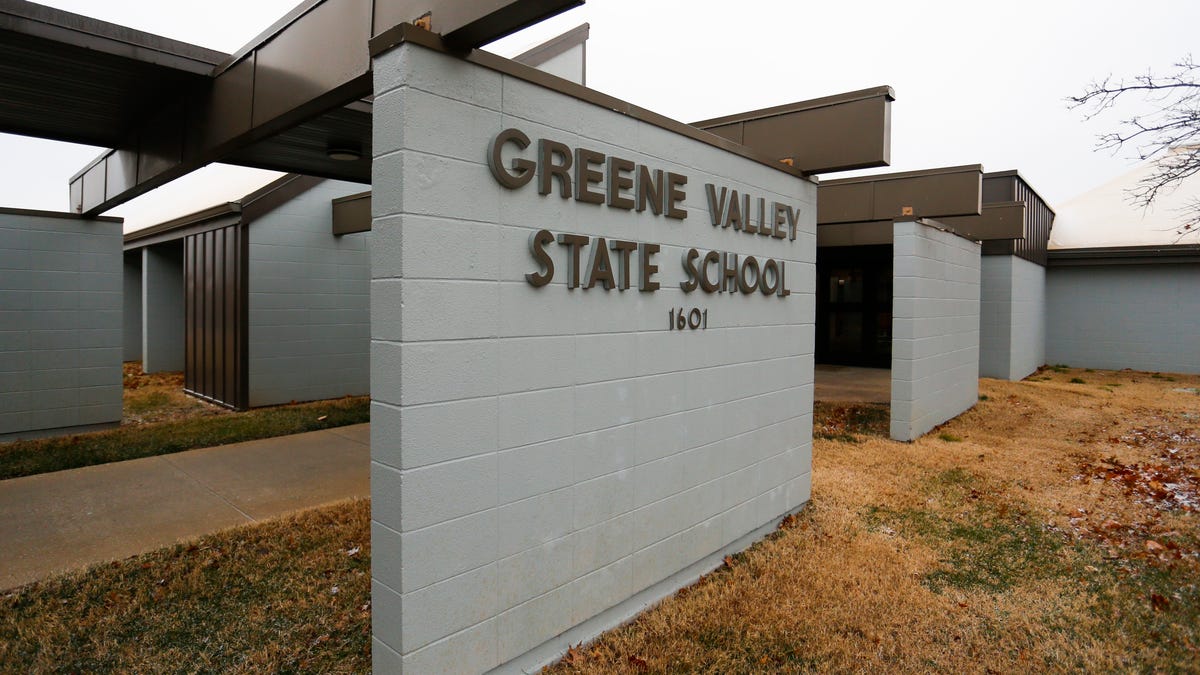Missouri
Missouri to explore ‘better model’ for educating students with severe disabilities

The Greene Valley State School, in Springfield, is bucking some of the challenges that are facing many of the other schools serving students with severe disabilities.
Missouri is home to a network of 34 state-operated schools serving students, ages 5-21, with severe developmental and learning disabilities. One of the largest is in Springfield.
The state authorized the creation of the Missouri Schools for the Severely Disabled in 1957 — years before a landmark federal law ensuring that students with disabilities have access to a free and appropriate education tailored to their individual needs within the least-restrictive environment — and the result was a set-up in Missouri unlike anywhere else in the U.S.
Now, more than six decades later, the state is trying to figure out if that system is working as intended or if changes ought to be made.
The Missouri Department of Elementary and Secondary Education, which operates MSSD, has spent the better part of the past year examining the network of schools: How they operate, where they are located, who they serve, and the quality of the education that is delivered.
“We are the only state who provides services this way,” said Missouri Commissioner of Education Margie Vandeven, in a meeting last week.
“We just want to make sure that we are providing the best services and if there are ways to do things differently … we are very open to hearing what our consultants have discovered.”
The state contracted with the Public Consulting Group, which delivered its first substantial report Dec. 5 to the state Board of Education. No decisions were made at that meeting.
Since Missouri appeared to be an anomaly in how services were provided, several board members asked if the state should be looking at a different way of serving the students.
Mary Schrag, of West Plains, questioned the appropriateness of the decades-long approach given the emphasis the federal law places on educating students alongside peers who may or may not have special needs.
“I’m very concerned about this whole situation and I am very concerned that the model is no longer where we need to be,” she said.
Overarching concerns noted in the report included declining enrollment, limited funding, inequitable facilities, and chronic shortages of teachers and staff.
Only 76% of the 500 staff positions needed across the network of schools are filled, leaving nearly one out of every four vacant.
Mark Wheatley, assistant commissioner in DESE’s Office of Special Education, said the staffing changes faced by the MSSD reflect the larger struggle in Missouri to find and keep enough qualified teachers in classrooms with students who have special needs.
“It was already an issue before we hit the current situation and current trends that we have,” he said. “That just amplified the need.”
The report included a range of recommendations — some with hefty price tags — to address concerns related to the conditions of schools, the safety of students and staff, and the adequacy of the educational environment.
“We are talking about 34 schools across an entire state and that in and of itself is a challenge when you look at consistency of programming and communication,” Wheatley said. “… It is a large challenge.”
Nearly all the state-owned schools were built in the 1970s and 1980s, although at least a portion were in leased space, and not all were originally constructed to serve as schools.
Consultants estimate there are $8.5 million in pressing facility needs such as new boilers and roofs and $10 million to add secure vestibules to entrances — an added security measure that many public districts including Springfield have prioritized.
“There are inequities across the schools,” said consultant Josh Chism. “It was apparent that some schools were nicer, some were not so nice. Some schools had great playgrounds, some had very small playgrounds. Some schools had nursing stations, some schools didn’t. All schools were doing their best to make it work.”
Facility differences were just one piece. The inequity showed up in other ways.
The amount of technology, adaptive equipment, Wi-Fi access, designated nursing spaces, and protocol for location of changing tables — for students who cannot use the restroom independently — were inconsistent.
Jennifer Baribeau, consultant, told the state board: “There were different resources available.”
Greene Valley school bucking trends
This was the state’s first large-scale review of the MSSD since at least 2006, when total enrollment topped 1,030. It has steadily dropped, hitting just 728 in 2022.
Officials said the drop was likely due to school districts making fewer referrals to state schools because they offer required services in-house or nearby. More families may also seek a schooling option closer to home.
The number of students enrolled in each of the state schools varies from fewer than 10 — the smallest in 2022 was the Skyview School in Mountain Grove with four students — to 40 or more.
Enrollment at Springfield’s Greene Valley State School was 42 this week, making it one of the largest in Missouri, and that number has grown in recent years.
“We are all focused on what can we do to enrich these kids that they don’t get outside of here,” said Greene Valley State School teacher Brandy Dittman.
She said the work is challenging and the days can be long and tough. “We are cheer-leading for everybody.”
Susan Morelock, who has been a teacher aide at Greene Valley for 32 years, said it takes the entire staff working as a team.
Dittman agreed. “Everyone has to be willing to help other … There are times I can be walking down the hall and I hear a teacher struggling with a student and I will stop and I will assist. It is all about comradery and being there for each other.”
A larger roster is just one way the Springfield school, sandwiched between Evangel University and Pythian Castle, is bucking the more challenging findings of the report.
More: Willard parents want students with special needs educated in ‘same building’ as peers
Teacher turnover was low, staff morale appeared high, and a slew of recent renovations to flooring, sinks and safety has resulted in improved working and learning spaces.
Giving a tour early Tuesday, Principal Eric Cheek said he was eager to show off the updated space, which includes an accessible playground.
“I am so proud of our building. We have opened up two new classrooms. Seven are now open. We are fully staffed. We have a wonderful, full-time cook. We have two nurses that are here all the time. We have substitute teachers and our therapists are here,” he said.
Cheek has been in the building for more than a decade, starting as a physical education teacher, and is in his second year as principal. The school employs more than 30 people.
He said higher pay and better benefits have reduced turnover but he can recall periods when staffing was not at the same level.
“It seemed like a revolving door. When you work in a real tough environment, you can get burned out,” Cheek said. “They have increased our salaries. They have increased our benefits and we are keeping people.”
The heart of the building is a commons area that doubles as an indoor gym with mobility equipment, floor padding and space for students to exercise and engage in activities.
He said students are grouped in different classes based on their age, abilities, and goals. Teachers place an emphasis on communication and life skills.
Greene Valley has a large service area, busing students each morning and afternoon from around Springfield and from cities up to two hours away. The school year is extended and physical, speech and occupational therapy is provided on-site, as it is needed.
“We’ve had students way up at the lake before, past Stockton. We’ve had kids as far as Lebanon and Branson and way out to Billings,” he said. “It is not just Springfield. It seems like we’re getting more from the outlying area.”
Exploring a ‘better model’
The report made a series of concrete recommendations that ranged from initiating a facilities master plan and conducting an instruction assessment to improving procedures and identifying potential funding sources for needed changes.
But the board, as a whole, appeared to push back. As the state continues to evaluate the MSSD, they encouraged the state and consultants to take a more holistic look.
Board member Pamela Westbrooks-Hodge, from Pasadena Hills, said the evaluation must identify the “root cause” of many of the issues identified in the report.
“Include in your roadmap how do we get to a better model. What other models do we need to study. What are the elements of those other models that are best that need to be infused in what we are doing,” Westbrooks-Hodge said.
“I am giving you permission to be bold, to think critically and employ systems-thinking to really get at how did we get into this mess. It is likely that the model doesn’t work anymore and we don’t have the right funding model.”
The report looked at how such services are provided in other states but did not point to a recommended option. A board member said more details about alternatives are needed.
Board president Charlie Shields urged caution, noting a change of that magnitude might be upsetting to MSSD parents and their input in any shift will be necessary.
“This is very near and dear to their heart because they are very protective of the services that their children receive,” he said.
“We always need to be sensitive when we talk about any new models.”
More: Missouri’s next commissioner of education is state senator, former school superintendent
Shields said any big changes would require the state board working closely with the Missouri General Assembly and the solution will likely be complex.
“This is an incredibly geographically diverse state so what works in one part of the state is not the solution in the other part of the state,” he said.
He called the report the start of an important discussion. He said any proposed change will have to have strong support and a sustainable funding stream.
Going forward, the consultants urged state education officials to see the report as a baseline. The consulting team said more work is needed to dig into potential models.
The board embraced the suggestion of studying the issue in more depth. There was discussion of any future report looking at short-term strategies and long-term options.
Given the length of time the state’s current approach has been in place, Schrag said an overhaul of some form is likely in order.
“When I talk about maybe we need to revise the model, I’m obviously not saying we need to get rid of (it) but it is really rare that something is still functionally appropriate 60 years later,” Schrag said. “This is a tremendously long period of time.”
Area MSSD schools
Of the 34 buildings operated by the Missouri Schools for the Severely Disabled, six are in southwest Missouri. They include:
- Greene Valley School, Springfield
- Oakview School, Monett
- College View School, Joplin
- Skyview School, Mountain Grove
- Cedar Ridge School, Nevada
- Ozark Horizon School, West Plains
Claudette Riley covers education for the News-Leader. Email tips and story ideas to criley@news-leader.com.

Missouri
Missouri high school football playoffs: State semifinals bracket, schedules

It’s state semifinal week for Missouri high school football.
Trips to next week’s state championship games in Columbia are on the line. All games across the state are scheduled for Saturday afternoon.
Class 1
- St. Vincent @ Adrian (Saturday, 1 p.m.)
- Tipton @ Penney (Saturday, 1 p.m.)
Championship on Dec. 7 at 3 p.m.
Class 2
- Bowling Green @ Lamar (Saturday, 1 p.m.)
- Fair Grove @ South Shelby (Saturday, 2 p.m.)
Championship on Dec. 6 at 3 p.m.
Class 3
- Lift for Life @ Seneca (Saturday, 1 p.m.)
- Maryville @ Blair Oaks (Saturday, 1 p.m.)
Championship on Dec. 7 at 11 a.m.
Class 4
- Festus @ Warrenton (Saturday, 1 p.m.)
- Lutheran North @ Kearney (Saturday, 1 p.m.)
Championship on Dec. 6 at 11 a.m.
Class 5
- Lafayette (Wildwood) @ Helias Catholic (Saturday, 1 p.m.)
- MICDS @ Platte County (Saturday, 1 p.m.)
Championship on Dec. 7 at 7 p.m.
Class 6
- Kirkwood @ Nixa (Saturday, 1 p.m.)
- Liberty @ De Smet (Saturday, 1 p.m.)
Championship on Dec. 6 at 7 p.m.
Missouri
Vote: Who should be Missouri high school Athlete of the Week? (11/25/2024)

Which Missouri high school athlete had the best week?
Each week, SBLive scours the state for the top fall and winter sports performers, from football to basketball from all contests in the week of Nov. 17-23. That included the state championships in boys soccer this past weekend.
Congrats to SLUH‘s Connor Dunker, who ran away as the leading vote-getter with 56% of the votes to win SBLive‘s Missouri Athlete of the Week for Nov. 11-16.
The junior won the 200-yard freestyle and was on the winning 400-yard freestyle relay. He also two medals for the Jr. Bills by taking third in the 500-yard freestyle and on the 200-yard freestyle relay.
Scroll down, read up on the nominees and cast your vote for your winner. Voting closes Sunday, Dec. 1 at 11:59 p.m. Central time.
If you would like to make a nomination in a future weeks, email swanson@scorebooklive.com.
MISSOURI ATHLETE OF THE WEEK NOMINEES
Henry Acorn, Rockhurst cross country
Competing in the Nike Cross Midwest Regional Championship on Sunday, the Virginia signee took sixth place. The Hawklets took second overall and advanced to the Nike National Championship.
Addilyn Amos, Troy Buchanan girls wrestling
Competing in her first Schuman Scramble, the team’s home meet, the freshman went 5-0 with five pins — three in the first period.
Terance Bills, Lafayette Wildwood football
The junior wide receiver caught a pair of touchdowns — 25 and 27 yards — in a 30-18 win over Cardinal Ritter in the Class 5 playoffs on Saturday.
Anna Bowles, Francis Howell girls wrestling
The junior posted a 5-0 mark to take first place for the Vikings at the St. Clair Scramble. She won the 125-pound title with five tech falls. Francis Howell won the team title as well.
Nic Calvaruso, Jefferson City Helias Catholic football
The junior booted a 36-yard field goal in OT to help the Crusaders claim a 24-21 win over Republic on Saturday, avenging a loss in the playoffs last year to the Tigers.
Jack Cooley, Hamilton Penney football
The running back scored twice and added an interception that led to a touchdown in the Hornets’ 35-13 win over North Platte in a district title game on Friday.
Zyree Collins, St. Mary’s South Side boys basketball
The Dragons scoring standout picked up where he left off last year. He scored 27 points, hitting 10 of 11 2-point shots, in an 86-34 St. Pius X Festus on Nov. 22.
Jackson Crews, St. Joseph Bishop LeBlond football
In what was a crazy finish to an 8-man game, LeBlond intercepted a hail mary at the buzzer and ran it back and then the senior got a lateral pitch and scored to give the Eagles a 60-54 win over Rock Port on Friday.
Jacob Eberhart, Kirkwood football
The wide receiver had seven catches for 158 yards and a touchdown and also had his first rushing touchdown of the season as the Pioneers beat Jackson on Friday.
Will Geary, Valley Park boys soccer
One of the best soccer players ever in MSHSAA capped off his career by leading the Hawks to the Class 1 title. He tied the state tournament record with 5 goals in a semifinal win and then added 2 goals and an assist in the title win. He broke the MSHSAA championship site record for most goals (7) and most points (15 points).
Josie Hosea, Kirkwood girls wrestling
At the Lady E. Ford Memorial Tournament in Affton, Hosea took first place in the 190-pound bracket. She won four of the five by pins in the first period.
Loganne Love, Principia girls basketball
The freshman had a double-double with 21 points and 10 rebounds on Saturday in a 79-42 win over St. Pius X (Festus) in Farmington.
Colton Miller, Adrian football
In the Class 1 District 3 championship game, he threw a touchdown, ran for a touchdown and kicked the game-winning field goal for the Blackhawks in a 17-16 win over Marionville.
Roman Miller, Seneca football
In a 55-26 win over Mount Vernon in the Class 3 quarterfinals, Miller accounted for three touchdowns on the ground for the Indians.
Jonathan Moore, Lutheran North football
The sophomore became the Crusaders’ single-season record holder for touchdowns in a season with 35, which happened during a playoff game on Saturday.
Sheek Pearson, John Burroughs boys basketball
The 6-foot-10 junior dropped in 20 points and grabbed 10 rebounds in a 72-57 win over Ladue Horton Watkins on Nov. 22.
Henry Sanders, SLUH boys soccer
The junior midfielder had the lone goal in 1-0 win against Liberty North in a Class 4 semifinal game on Friday. SLUH then beat De Smet on Saturday to win the state title.
Alyzah Scaggs, Festus girls basketball
The Lady Tigers got 25 points from the junior in a 64-49 win over West County (Leadwood) in the Farmington Tournament on Saturday. Scaggs drained six 3-pointers on the night.
Dane Schlotzhauer, Tipton football
The junior connected with Paxton Pyle for the game-winning touchdown with less than a minute left to give the Cardinals a 42-36 win over Harrisburg to claim Class 1 District 2 finals. It was the first district crown for Tipton since 2012.
Sadie Sehnert, Wright City girls wrestling
The junior didn’t have to wrestle for more than 1:05 in her five matches on Saturday at the Wright City Invitational. She had two pins in 30 seconds or less to win the 135-pound bracket.
Jordan Speiser, Lutheran St. Charles girls basketball
The Lady Cougars picked up a 61-57 win over Alton, Ill., on Saturday behind Speiser’s 29-point effort. The Kansas State signee went 10-for-10 from the free-throw line and hit 5 3-pointers.
Carter Temple, Kearney football
The Bulldogs starting quarterback ran for four touchdowns as the Bulldogs won their 24th straight in a 49-14 triumph over Warrensburg on Friday.
Seaton Thompson, Ladue Horton Watkins boys soccer
He stopped every shot in the state semifinals and finals and helped the Rams win the Class 3 title. He had shutouts in both wins.
Wyatt Vincent, Nixa football
He caught the game-winning touchdown with 10.4 left in the fourth to help the Eagles rally for a 21-20 win over Lee’s Summit North in a Class 6A playoff game.
Niko Vuong, Clayton boys soccer
The junior scored a goal in a 4-0 win over Logan-Rogersville in the semifinals and added a goal in a 3-0 win over St. Michael the Archangel in the Class 2 finals on Nov. 21. The state title was the first for the Greyhounds.
Editor’s Note: Our Athlete of the Week feature and corresponding poll are intended to be fun, and we do not set limits on how many times a fan can vote during the competition. However, we do not allow votes that are generated by script, macro or other automated means. Athletes who receive votes generated by script, macro or other automated means will be disqualified
Missouri
Live Updates: Missouri Men’s Basketball vs. Arkansas Pine Bluff

Missouri men’s basketball just keeps rolling.
The Tigers strung together their fifth straight win, this time defeating Arkansas Pine Bluff in a 112-64 blowout at home Sunday afternoon. The second half struggles that have typically come to bite them didn’t appear, instead pushing the same offensive pace until the very end of the contest.
Junior Mark Mitchell was the star of the show for Missouri. The forward scored a season-high 20 points on 8-of-11 shooting, paired with five rebounds and a block. Although not a threat on the perimeter, his offensive prowess inside the paint gives the Tigers a consistent option.
Graduate senior Caleb Grill continued his dominance from behind the arc, dropping 14 points on 5-of-9 shooting from the field and 4-of-8 shooting from 3-point range. Senior Tamar Bates also added 13 points of his own on 5-of-8 shooting from the field.
Perhaps the most impressive performance of the night, however, came from sophomore Anthony Robinson II. The guard was everywhere on both sides of the ball, recording a double-double of 11 points, 11 rebounds, seven assists and a block on 3-of-7 shooting from the field.
It was the first double-double of Robinson’s young career at Missouri.
The Tigers did struggle to shoot the 3-pointer compared to previous games, finishing with just a 9-of-32 clip. That was negated by their 54 points in the paint, as well as their ability to prevent the Golden Lions from having success in their own right.
Arkansas Pine Bluff shot 9-of-28 from three — a more efficient night of shooting, but on less attempts compared to Missouri. It also turned the ball over 19 times, allowing the Tigers 33 easy points off them.
Missouri also had an uncharacteristically good game under the basket, grabbing 19 offensive rebounds that resulted in 24 second-chance points. Five of those rebounds came from Robinson.
Before Thanksgiving arrives, the Tigers will go up against Lindenwood at 5:30 p.m. Wednesday in Mizzou Arena.
|
Arkansas Pine Bluff |
|
|---|---|
|
Christian Moore |
Anthony Robinson II |
|
Zach Reinhart |
Tamar Bates |
|
Caleb Jones |
Annor Boateng |
|
Klemen Vuga |
Mark Mitchell |
|
Quentin Bolton Jr. |
Josh Gray |
Who: Missouri Tigers (4-1, 0-0 SEC) vs. Arkansas Pine-Bluff Golden Lions (1-5, 0-0 SWA)
What: Missouri’s sixth game of the 2024-’25 season
Where: Mizzou Arena in Columbia, Mo.
When: Sunday, November 24, 4:00 p.m.
TV: ESPN+, SECN+
Radio: Tiger Radio Network
Series: Missouri leads 3-0
Last Meeting: Nov. 6, 2023: Missouri opened the season with a 101-79 win over Arkansas Pine-Bluff. Five different players scored over 15 points for Missouri, including Sean East II, Nick Honor, Noah Carter, Caleb Grill and Tamar Bates.
Last Time Out, Missouri: The Tigers handled business in a 91-56 win over Pacific. Guard Caleb Grill continued a hot streak, leading the team with 25 points, including 21 from three-point makes. Grill also notched a career-high with five steals.
Last Time Out, Arkansas Pine-Bluff:The Golden Lions fell on the road to Texas Tech, losing 98-64. Arkansas Pine-Bluff shot 52.1% from the field while Texas Tech shot 59.7%. The Golden Lions were led by guard Christian Moore with 20 points.
-

 Business1 week ago
Business1 week agoColumn: Molly White's message for journalists going freelance — be ready for the pitfalls
-

 Science6 days ago
Science6 days agoTrump nominates Dr. Oz to head Medicare and Medicaid and help take on 'illness industrial complex'
-

 Politics1 week ago
Politics1 week agoTrump taps FCC member Brendan Carr to lead agency: 'Warrior for Free Speech'
-
/cdn.vox-cdn.com/uploads/chorus_asset/file/25739950/247386_Elon_Musk_Open_AI_CVirginia.jpg)
/cdn.vox-cdn.com/uploads/chorus_asset/file/25739950/247386_Elon_Musk_Open_AI_CVirginia.jpg) Technology1 week ago
Technology1 week agoInside Elon Musk’s messy breakup with OpenAI
-

 Lifestyle1 week ago
Lifestyle1 week agoSome in the U.S. farm industry are alarmed by Trump's embrace of RFK Jr. and tariffs
-

 World1 week ago
World1 week agoProtesters in Slovakia rally against Robert Fico’s populist government
-

 Health2 days ago
Health2 days agoHoliday gatherings can lead to stress eating: Try these 5 tips to control it
-

 News1 week ago
News1 week agoThey disagree about a lot, but these singers figure out how to stay in harmony



















